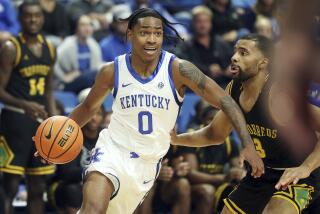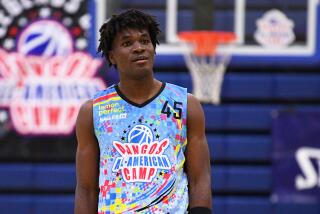Graduation Rates Lagging
- Share via
With college basketball on the verge of its annual March Madness extravaganza, an independent study released Tuesday found that nearly two-thirds of the teams in the men’s NCAA tournament have graduated less than 50% of their players.
Among the top programs cited for poor academic achievement were No. 4-ranked Louisville at 17% and No. 6 Oklahoma State at 11%.
UCLA, heading for Tucson to face Texas Tech in the first round, was listed with a graduation rate of 33%, though university officials questioned the accuracy of that number.
Suggesting that academic issues can be overshadowed by tournament glitz -- the pep bands and last-second shots, the billion-dollar television contract -- Richard Lapchick, who directs the study out of the University of Central Florida, characterized the situation as “a continuing nightmare.”
At NCAA headquarters in Indianapolis, President Myles Brand praised the study for “making it clear where the problems lie in college sports.”
The NCAA recently launched sweeping reforms that for the first time will seek to penalize teams for substandard performance in the classroom. Sanctions will include loss of scholarships and exclusion from postseason play.
But the new policies do not begin to take effect until the fall and, although Lapchick is hopeful they will bring change, the noted sports ethicist said his study suggests the NCAA has a long way to go.
Nationwide, about 58% of all college students graduate within six years of entering school.
Male basketball players have traditionally lagged behind that standard and behind their colleagues in other sports. As part of an annual survey, the NCAA recently scrutinized freshman classes entering school from 1994 through 1997 and found that only 43% of male basketball players graduated within six years. By comparison, football had a 53% rate and baseball had a 47% rate.
Using the same NCAA numbers, Lapchick’s study showed that 42 of the 65 teams in the men’s tournament this week fell below the 50% mark. Looking at men’s basketball overall, he noted that African American players ranked 5% below the 43% rate for all players.
“That, to me, is the most disheartening thing,” Lapchick said.
Results for the 64 teams in the women’s tournament were more encouraging, with only six teams below 50%.
USC had a 75% rate and UC Santa Barbara was at 67%.
But, again, Lapchick pointed out that black female athletes fell 5% below the overall rate of 65%. He also found that 27 major college teams had not graduated a single black female player in the six-year time frame.
“Everybody has been saying that men’s problems might creep into the women’s game,” he said. “This is the first indication I’ve seen of the potential of that happening.”
NCAA officials, while sharing his concerns, said the method used to measure graduation rates, developed by the federal government, contains several flaws.
As it stands, an athlete who transfers to another school is counted as a failure, even if he or she eventually graduates. An athlete who leaves school to turn professional -- even with an “A” average -- similarly counts against the rate.
At UCLA, for example, omm’A Givens transferred to Pepperdine in 1996. Two years later, Travis Reed transferred to Long Beach State and Baron Davis went through the 1999 NBA draft as a sophomore. All of this lowered the school’s rate.
“The university has been dinged for individuals who have transferred or gone professional in the past,” Athletic Director Dan Guerrero said. He said the 33% rate “isn’t reflective of what UCLA basketball is today.”
Under the new NCAA policies, such discrepancies will be accounted for.
As for black athletes, Brand pointed out that even with their lower rates, they graduate at a higher percentage than their counterparts in the general student population.
More to Read
Go beyond the scoreboard
Get the latest on L.A.'s teams in the daily Sports Report newsletter.
You may occasionally receive promotional content from the Los Angeles Times.











